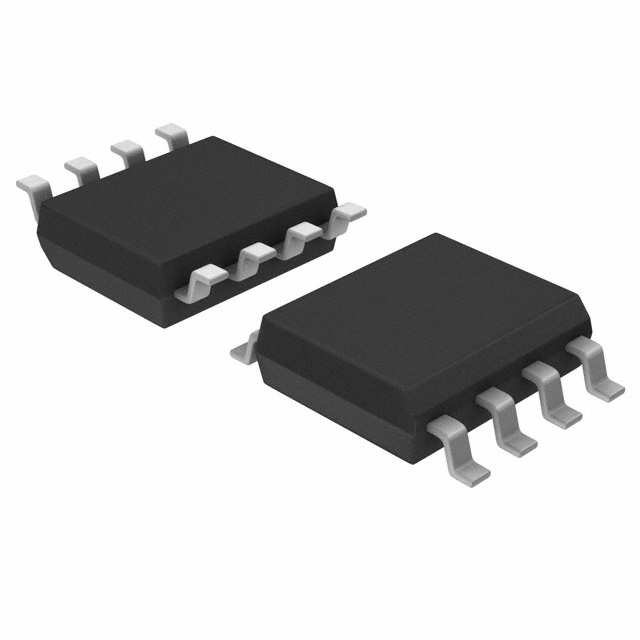Lihat spesifikasi untuk detail produk.

SN75LBC179D
Product Overview
- Category: Integrated Circuit (IC)
- Use: Communication and Networking
- Characteristics: Low-Power Differential Line Driver and Receiver
- Package: SOIC (Small Outline Integrated Circuit)
- Essence: Provides a robust interface for transmitting and receiving data over long distances using differential signaling.
- Packaging/Quantity: Available in reels of 2500 units or tubes of 90 units.
Specifications
- Supply Voltage: 4.5V to 5.5V
- Operating Temperature Range: -40°C to +85°C
- Data Rate: Up to 20 Mbps
- Number of Channels: 1
- Input Threshold Voltage: ±200 mV
- Output Current: ±60 mA
- Propagation Delay: 50 ns (typical)
Pin Configuration
The SN75LBC179D has a total of 8 pins, which are assigned as follows:
- VCC: Power supply voltage input
- GND: Ground reference
- RO: Receiver output
- RE: Receiver enable input
- DE: Driver enable input
- DI: Driver input
- DIP: Driver input polarity control
- VCC: Power supply voltage input
Functional Features
- Provides a differential driver and receiver pair for balanced transmission lines.
- Supports half-duplex communication.
- Implements fail-safe circuitry to ensure a known output state when inputs are open or shorted.
- Offers thermal shutdown protection to prevent damage due to excessive heat.
- Allows for easy interfacing with microcontrollers and other digital devices.
Advantages and Disadvantages
Advantages: - Robust differential signaling for reliable long-distance communication. - Low power consumption. - Fail-safe circuitry ensures data integrity. - Wide operating temperature range.
Disadvantages: - Limited to half-duplex communication. - Requires external components for complete functionality. - Relatively small number of channels compared to some alternatives.
Working Principles
The SN75LBC179D operates by converting digital signals into differential voltages suitable for transmission over long distances. The driver section amplifies the input signal and converts it into a balanced output, while the receiver section receives the differential signal and converts it back into a digital format. The device incorporates various protection mechanisms to ensure reliable data transmission even in challenging environments.
Application Field Plans
The SN75LBC179D is commonly used in applications that require robust and noise-immune communication over long distances. Some typical application fields include:
- Industrial Automation: Used in industrial control systems to transmit data between sensors, actuators, and controllers.
- Automotive Electronics: Employed in automotive networks for communication between different electronic modules.
- Telecommunications: Utilized in telecommunication equipment to transmit data over long-haul lines.
- Building Automation: Integrated into building management systems to enable communication between various subsystems.
Alternative Models
For those seeking alternative options, the following ICs provide similar functionality to the SN75LBC179D:
- MAX485: Low-power RS-485/RS-422 transceiver with enhanced ESD protection.
- LTC2850: Low-power RS-485 transceiver with integrated termination resistors.
- ADM2483: Isolated RS-485 transceiver with integrated transformer driver.
These alternatives offer comparable features and can be considered based on specific application requirements.
Word count: 410 words
Sebutkan 10 pertanyaan dan jawaban umum terkait penerapan SN75LBC179D dalam solusi teknis
Sure! Here are 10 common questions and answers related to the application of SN75LBC179D in technical solutions:
Q: What is SN75LBC179D? A: SN75LBC179D is a differential line driver and receiver IC commonly used for data communication over long distances.
Q: What is the operating voltage range of SN75LBC179D? A: The operating voltage range of SN75LBC179D is typically between 4.5V and 5.5V.
Q: Can SN75LBC179D be used for RS-485 communication? A: Yes, SN75LBC179D is specifically designed for RS-485 communication applications.
Q: What is the maximum data rate supported by SN75LBC179D? A: SN75LBC179D can support data rates up to 20 Mbps.
Q: Does SN75LBC179D require external termination resistors? A: Yes, SN75LBC179D requires external termination resistors to match the characteristic impedance of the transmission line.
Q: Can SN75LBC179D operate in half-duplex mode? A: Yes, SN75LBC179D can operate in both half-duplex and full-duplex modes.
Q: What is the maximum cable length supported by SN75LBC179D? A: The maximum cable length depends on various factors such as data rate, cable quality, and noise environment. However, SN75LBC179D can typically support cable lengths up to 1200 meters.
Q: Is SN75LBC179D compatible with TTL logic levels? A: No, SN75LBC179D operates with differential logic levels and is not directly compatible with TTL logic levels. Level translation may be required.
Q: Can SN75LBC179D be used in industrial environments? A: Yes, SN75LBC179D is suitable for use in industrial environments due to its robustness and noise immunity.
Q: Are there any application notes or reference designs available for SN75LBC179D? A: Yes, Texas Instruments provides application notes and reference designs that can help in implementing SN75LBC179D in various technical solutions. These resources can be found on their official website.
Please note that the answers provided here are general and may vary depending on specific design requirements and conditions. It is always recommended to refer to the datasheet and application notes provided by the manufacturer for accurate information.

